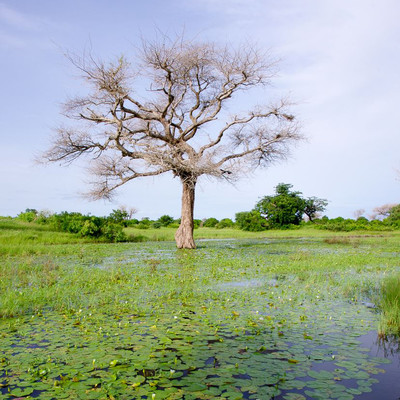
This article contributed by ECHOcommunity member Bob Hargrave.
No, fertilizer as we normally think of it doesn’t grow on trees! But agroforesters and other agriculturalists are using this term for any tree that helps improve the quality of soil. One great example is the Apple Ring Acacia (Faidherbia albida). The Apple Ring Acacia is an unusual tropical nitrogen-fixing tree in that it drops its leaves in the rainy season thus adding some fertility to the soil underneath. It then leafs back out in the dry season. In temperate climates that would sort of be like our trees losing their leaves in the summer and leafing out in the winter!
ECHO publicized this tree in ECHO Development Notes issue #107, and encourage planting it as part of a farmer’s strategy to keep land productive in a sustainable way.
Reading ECHO intern alumni Noah and Katie’s blog I see that they have these trees on their site in Senegal. Their posts include some great pictures:

A group of cows take shelter under a Faidherbia aldbida tree (apple ring acacia) in Senegal. Photo by Noah Elhardt (used with permission)
March 30th, 2015
Faidherbia albida, or Apple ring acacia. This deep-rooted Sahelian tree is famous for leafing out in the dry season and dropping its leaves in the wet season, unlike the vast majority of trees which do the opposite. (In fact, the term “reverse leaf phenology” is most often associated with this species.) This trait has saved this tree from the fate of most Sahelian trees. Its value to farmers is at least threefold:
- The plentiful and tasty seed pods and foliage provide valuable forage to livestock during the long dry season.
- Livestock, attracted by these treats and by the shade created by the dry-season foliage, spend a lot of time underneath these trees, fertilizing the field as they do.
- The nitrogen-rich leaves, dropped just at the start of the rainy season, provide another source of organic inputs for the crops grown underneath.
This tree, near the farm where I work, is providing shade for cattle, sheep AND goats. 3 months to go till rainy season!

A Faidherbia aldbida tree (apple ring acacia) shows little to no foliage during the rainy season in Senegal. Photo by Noah Elhardt (used with permission)
Nov. 7th, 2015
We’re back in lovely green Senegal! Remember that picture I posted a few months ago of an Apple ring acacia (Faidherbia albida) providing shade for livestock in the dry season? Here is the same species in the wet season.

A farmer in Senegal gathers Faidherbia aldbida branches to use for fenching. Photo by Noah Elhardt (used with permission)
May 31, 2017
Faidherbia albida: the Giving Tree. Shade when you need it, none when you don’t. Forage to feed your animals in the dry season or, when you want to keep them out of your garden, thorny branches to build a fence with. This farmer is fencing in his mango trees at the beginning of fruiting season.

Semi-Arid crops grow in the understory of Faidherbia aldbida trees on the ECHO Global farm. Photo by Bob Hargrave. (used with permission)
At ECHO these trees are growing where they are highlighted on our public tour as one of the sustainable practices we are “echoing” out to our global network.
Bob is an ECHOcommunity member, avid birder, and technical advisor at ECHO. You can find his blog at http://behargrave.net/
Noah and Katie can be found in Senegal working at the Beer-Sheba project: http://beershebaproject.org/